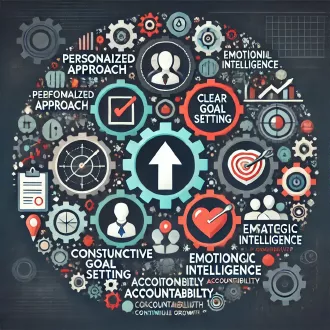Transcription Knowing the client. Formulating positive assumptions
In the leadership coaching process, a vital aspect that is at the epicenter is the ability to build positive assumptions in relation to the coachee. This practice is not only present in every meeting, but is constantly woven into the essence of coaching.
It is a kind of foundation on which all development is built. However, the concept of positive assumptions may seem intangible and somewhat ethereal in nature. It is a concept that transcends the superficial and dives into the depths of thought and perspective.
If we delve into this realm of positive assumptions, we discover that it is more than kind and hopeful words. It is a mindset, a posture that encompasses the perception you have of the individual you are guiding. When you look at your coachee, what do you see? Are you able to glimpse beyond apparent limitations and into the realm of their potential? Do you recognize the strengths that lie within them? This is the threshold from which the real coaching process begins.
It is as if you are looking through a lens that highlights the positive and the promising. By offering this vision in your interactions with the client, you establish fertile ground for confidence and self-esteem.
It's as if you are saying to them:
- "I know you have what it takes to meet challenges and achieve your goals."
By creating this environment of safety and openness, you inspire your client to embrace their own potential and move forward with confidence.
Imagine the impact this practice can have on the individual being guided. When greeted with positive assumptions, the client feels validated, understood and respected in their developmental journey. These assumptions, far from being simple statements, become a reflection of how you relate to them. Your belief in their potential translates into tangible support that drives them to take bold action and face challenges with courage.
But here's the key: it's not simply an act of blind faith. Beyond the rhetoric, these assumptions are rooted in hard facts. Every individual, even in their moments of greatest doubt or insecurity, carries with them past accomplishments, deep desires and underlying capabilities. What are those accomplishments? What are their good intentions? This will help you connect with your client. As a coach, your task is to uncover these hidden gems and bring them to light.
However, the process of building positive assumptions is not limited to the coach's perspective alone. It requires deep self-awareness and an understanding of your own biases and prejudices. Recognizing these personal biases is essential to ensure that the assumptions you make are genuinely positive and not influenced by prior judgments.
In addition, it is important to accompany words with the right body language. Gestures and posture translate your true thoughts or feelings better than anything else, and human beings are more than predisposed to interpret them. If there is any conflict between what you say with words and what you express with your body, the coachee will pick it up consciously or unconsciously.
This does not mean that you ignore difficulties or obstacles. In fact, it is quite the opposite. By recognizing and addressing mental barriers that may be getting in the way, you open the door to new perspectives and solutions. It's a delicate balance between support and challenge, between recognizing reality and glimpsing potential.
On this journey, your empathy plays a crucial role. Don't immerse yourself in the client's problems or fears, but don't ignore them either. Your empathy allows you to understand their obstacles and, at the same time, drives you to design concrete actions to overcome them. It's a path that requires effective communication and an attitude of constant growth. At the end of the day, formulating positive assumptions about your customer is more than a technique, it's a holistic approach. It is a perspective that influences how you interact, how you lead and how you view human potential. By taking this stance, you become a catalyst for change, a beacon of possibility and a partner on the path to growth and success.
positive assumptions




